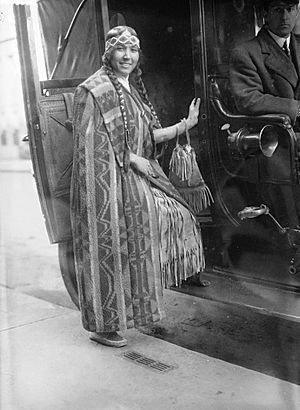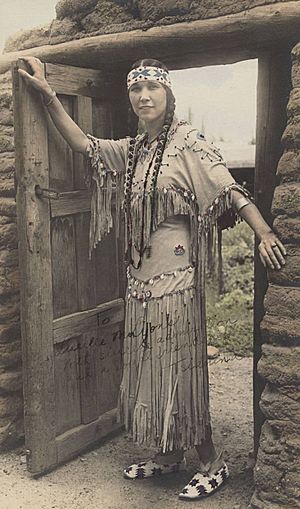Tsianina Redfeather Blackstone facts for kids
Quick facts for kids
Tsianina Redfeather
|
|
|---|---|

Tsianina Redfeather in 1915
|
|
| Born | December 13, 1882 |
| Died | January 10, 1985 (aged 102) |
| Nationality | Muscogee Nation, American |
| Other names | Tsianina Blackstone, Tsianina Grayson, Princess Tsianina Redfeather, Florence Tsianina Evans |
| Occupation | opera singer and activist |
|
Notable work
|
Libretto for Shanewis |
Tsianina Redfeather Blackstone (born December 13, 1882 – died January 10, 1985) was a talented singer and a strong voice for Native American people. She was born in Eufaula, Oklahoma, in the Muscogee Nation. Tsianina had both Cherokee and Creek heritage. She was one of ten children, and everyone noticed her special musical talent.
Starting in 1908, Tsianina traveled a lot with Charles Wakefield Cadman, a composer and pianist. He gave talks about Native American music, and she would sing his songs. They performed all over the United States and Europe. Tsianina also helped create an opera called Shanewis (which means "The Robin Woman"). This opera told stories inspired by her own life and important issues for Native Americans. It was first shown at the famous Metropolitan Opera. Tsianina later sang the main role herself when the opera toured. After her singing career, she became an activist, working to improve education for Native American children. She helped start the American Indian Education Foundation and supported studies about Native American history and cultures.
Contents
Tsianina's Early Life and Heritage
Tsianina Redfeather was born Florence Tsianina Evans in Eufaula, Oklahoma. Her family belonged to the Muscogee Nation. A long time ago, her ancestors, like many other Native American people, had to move from their homes on a difficult journey known as the Trail of Tears.
Tsianina was one of ten children, and her family was very musical. She showed the most talent for singing. When she was 14, she began her music training in Denver, Colorado. She earned scholarships to study music in both Denver and New York City. During her training in Denver, Tsianina became a very skilled mezzo-soprano singer. There, she met Charles Cadman, a pianist who would later become her touring partner.
Tsianina's parents were Wiley and Lettie Evans. Her family had a rich heritage, including connections to the famous Chief Tecumseh. Her parents were of mixed heritage, including Native American and African American roots. Her mother's family had experienced slavery. These family experiences helped shape Tsianina's strong desire to work for fairness and education for all people.
A Star on Stage: Tsianina's Singing Career
When Tsianina was 26, she began touring with Charles Wakefield Cadman. He was a pianist who studied and shared Native American music. Together, they gave many concerts across North America and even in Europe. Cadman would give talks about Native American music, and Tsianina would sing his beautiful songs.
Tsianina was known as "Princess Tsianina Redfeather" during her performances. She wore traditional clothing and her hair in long braids. She even decorated her own outfits and special headband. Cadman wrote a famous song just for her called "From The Land of Sky-Blue Water," which became her signature tune.
Creating the Opera Shanewis
Tsianina worked with Cadman and a writer named Nelle Richmond Eberhart to create an opera called Shanewis, or "The Robin Woman." This opera told stories inspired by Tsianina's own life and the experiences of Native Americans at that time. It was first performed at the Metropolitan Opera in 1918 and was very popular. Tsianina later sang the main role herself during the opera's tour, making her opera debut in Denver in 1924. She also performed it in Los Angeles in 1926.
Entertaining Troops During World War I
During World War I in 1918, Tsianina led a group of Native American entertainers. They traveled to France and Germany to perform for American soldiers. Their show was called "The Indian of Yesterday and Today." General John J. Pershing honored Tsianina for being one of the first women to volunteer to entertain the troops. She was also the first woman to cross the Rhine River to reach U.S. troops in Germany.
Honored by a Community
In 1922, Tsianina performed for a group of people who were building a resort near Fort Collins. They were so impressed by her singing that they named their new mountain village "Red Feather" in her honor. They also gave Native American names to many other places in the area.
Tsianina's Work for Native American Education
In 1935, Tsianina stopped her singing tours, but she continued to work on important issues for Native American people. She helped start the American Indian Education Foundation (AIEF). This organization works to improve education for Native American children.
She also served for 30 years on the Board of Managers for the School of American Research in Santa Fe, New Mexico. This school helps with studies about Native American history and cultures.
Tsianina's Personal Life and Legacy
Tsianina Redfeather was known for her kindness and generosity. She personally helped fund the education of at least two children from her tribe. Even though she was a famous singer, she made sure to contribute to scholarships for children in the Muscogee Creek Nation. She also started a group called The First Daughters of America, which supported Native American women.
Tsianina married David F. Balz in 1920. Later, she married again to a man named Blackstone. She eventually settled in California, living with her niece, Wynemah Blaylock, first in Burbank and then in San Diego.
Tsianina lived a very long life, passing away in 1985 at the age of 102. A priest who knew her described her as a "lovely, lovely person" and "an outstanding person."
Preserving Her Heritage
Tsianina was proud of her heritage. She made sure to share her tribal enrollment card number and legal name, Florence Evans, to confirm her Muscogee lineage. This was important to her, as she wanted to ensure her family's history was accurately recognized.
It's interesting to note that even though she was a famous singer, many of Tsianina's performances were not recorded. This was because her tribe had concerns about sacred Native American art and customs being used improperly.
Images for kids



